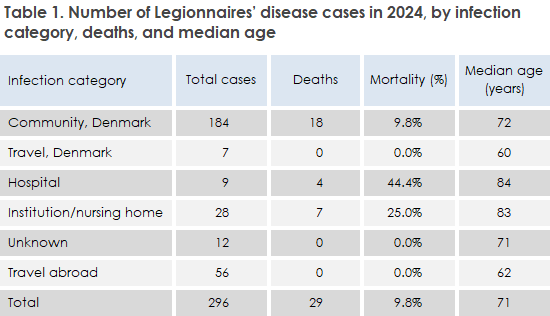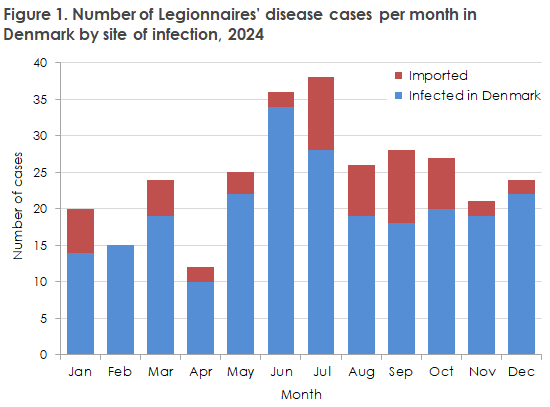No 27 - 2025
Legionnaires’ Disease in Denmark 2024
Legionnaires’ Disease in Denmark 2024
- In 2024, there were 296 laboratory-confirmed cases of Legionnaires’ disease (LD).
- The incidence of 4.0 per 100,000 represented a slight decline in domestically acquired cases compared with previous years.
- Approximately 60% of the cases were men.
- Legionella non-pneumophila accounted for about one-third of all cases in the Capital Region.
- Most cases occurred in June and July.
- For foreign travel, it is recommended to let all water in the bathroom run for a few minutes before showering and check whether the hot water gets hot enough.
In 2024, a total of 296 cases of Legionnaires’ disease were registered among residents of Denmark. Of these, 180 were men (median age: 70 years) and 116 were women (median age: 71.5 years). Mortality was 9.8%, the same level as in 2023 (approx. 10%) and corresponding to the pre-COVID-19 level, see Annual Report 2023.
The majority of cases (240; 81%) were infected in Denmark (including unknown category), (Table 1). With an average incidence of 4.0 cases per 100,000, this was a slight decrease compared with previous years, but the geographical distribution was roughly the same as in 2023.
For a detailed epidemiological overview, see the Annual Report 2024.

There were most LD cases in June and July, with 36 and 38 cases respectively. Travel-related (imported) cases occurred in all months except February. Most travel-related cases were registered from July to October—34 cases in total (67.9%). Most domestically infected cases were observed in June, with 34 cases (Figure 1).

A total of 56 cases were registered as infected abroad, most commonly in Italy (17), Greece (9), and Turkey (9). Infection typically occurs via water installations where Legionella has had favorable growth conditions. People with COPD, smokers, and the elderly may be more vulnerable and should exercise caution and observe standard prevention measures, see Annual Report 2024. It is also recommended to flush all taps thoroughly with both cold and hot water after travel or other absences from the home.
A significant initiative in 2024 was species identification of Legionella non-pneumophila through 23S–5S sequencing of PCR-positive samples. Of 36 non-pneumophila cases (positive for Legionella species, negative for L. pneumophila), the species could be identified in 19 cases. Identified species included L. longbeachae (six), L. anisa (four), L. bozemanae (two), L. rubrilucens (two), and five other species with one case each, see Annual Report 2024.
Most non-pneumophila cases (34) were detected in the Capital Region: seven by PCR and culture, 14 by PCR and 23S–5S sequencing, and 13 by PCR alone. Overall, non-pneumophila accounted for about 32% of all 107 diagnosed cases (including imported) in the Capital Region. In Southern Jutland, at least seven non-pneumophila cases were detected (two by culture). In total, 41 confirmed Legionella non-pneumophila cases were detected nationwide, but the actual number is assumed to be considerably higher.
In 2024, a total of 12 L. longbeachae cases were detected. This species differs by not being waterborne but is instead found in soil and compost products. In 2024, it was isolated from soil products in five out of six patients where samples were tested. Preventive measures include good hand hygiene, use of gloves, moistening soil to reduce dust, and handling soil outdoors in fresh air rather than indoors (e.g. in greenhouses).
(S. Uldum, J.S. Sparvath, Bacteria, Parasites and Fungi, C. Eves, C. Kjelsø, Department of Infectious Disease Epidemiology and Prevention)